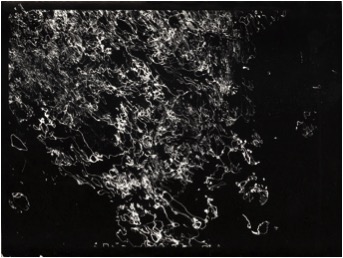
Sunlight on Water, 1943
Harry Callahan (1912–1999)
Sunlight on Water, 1943
Vintage gelatin silver print
8.3 x 11.1 cm
Courtesy The Estate of Harry Callahan and Pace/MacGill Gallery, New York
When Harry Morey Callahan (Detroit, Michigan, 1912–Atlanta, Georgia, 1999) attended a photography workshop led by Ansel Adams in 1941, he was impressed not only by the technical quality of Adams's majestic black-and-white landscapes but also by the older artist's unshakable belief in the idea that photography was an independent art form[1]. As a result of this experience, Callahan decided to become an artist and made photography his medium. Adams also taught him that one didn't have to travel in order to find inspiration, for even our own footprints on the ground can be an interesting subject. Callahan therefore began to zoom in on the details, the close-ups and urban spaces around him, focusing on capturing the nuances of light and shadow and not just the objects.
Nearly every morning, he set out to ramble through the city where he lived and took numerous photos. In the afternoon, he tested and experimented with the best negatives obtained that day in his darkroom. His favorite themes were little details discovered on the city streets: weeds, telephone wires, skyscrapers, etc. He would choose a theme, photograph it in many different ways, and repeatedly return to it over a period of time. Callahan's work was intimately bound up with his own life. Over fifteen years, he photographed his wife Eleanor in a variety of locations and contexts: at home, on the city streets, in the landscape; alone or with their daughter; in black-and-white and in color; nude and clothed; up close and from a distance.
His scenes have a unique lighting and camera motion and show a strong sense of line and form, and light and darkness[2]. In some cases, Callahan exposed his photographic negatives to light several times. By moving the camera he could even "draw" with light, using it to generate lines and forms. Other photographs present extreme contrasts: in these prints, practically the entire image is either black or white, as we see in Sunlight on Water (1943), where the background is completely black and only a few white squiggles suggest the ripples of the water. By photographing sunlight reflected on the still waters, he created a delicate image that seems to transcend the photographic medium, crossing over to painting and drawing. This photo evidences Callahan's attraction to simple things, ordinary objects and scenes which he transformed into lines and rhythms. His work proves that even a photograph devoid of figurative elements can elicit emotions and tell a story. Here Callahan chose a fragment of reality, sunlight reflected on the water, with highly evocative plastic qualities. The lack of context makes the subject difficult to read, and in this sense the composition is similar to the works being produced at the time by painters in the school of Abstract Expressionism. It was, in short, a new way of seeing and capturing reality. In the same way that painters like Jackson Pollock created their abstract works, Callahan reduced nature to simple yet poetic lines and planes of color, applying the ideas of Abstract Expressionism to the photographic medium. There is a synergy between painting and photography on the road to abstraction.
Preguntas
Observe the work carefully before reading the title. What stands out to you in the image? If you had to guess what the artist photographed, what would you say? Make a list of things that come to mind.
Callahan’s photos are abstractions of nature. Read the title of the work. Now that you know what it is, does it change how you see the photo? How similar or different is this image from what you guessed the artist had photographed? Why do you think Callahan chose to portray nature this way?
Callahan exposed some of his photographic negatives to light several times. This allowed him to create extreme contrasts in his scenes. For example, sometimes the background is almost completely black. Why do you think he took the photograph that way? What effect did he hope to achieve? Do you think he succeeded? Why? How would it change if this were a color photograph? What would be different?
Use a ruler to trace the outline of the work to scale (8.3 x 11.1 cm) on a sheet of paper. How do you think your perception would change if it were ten times larger? How do you think the size of the work affects the way you see it?
